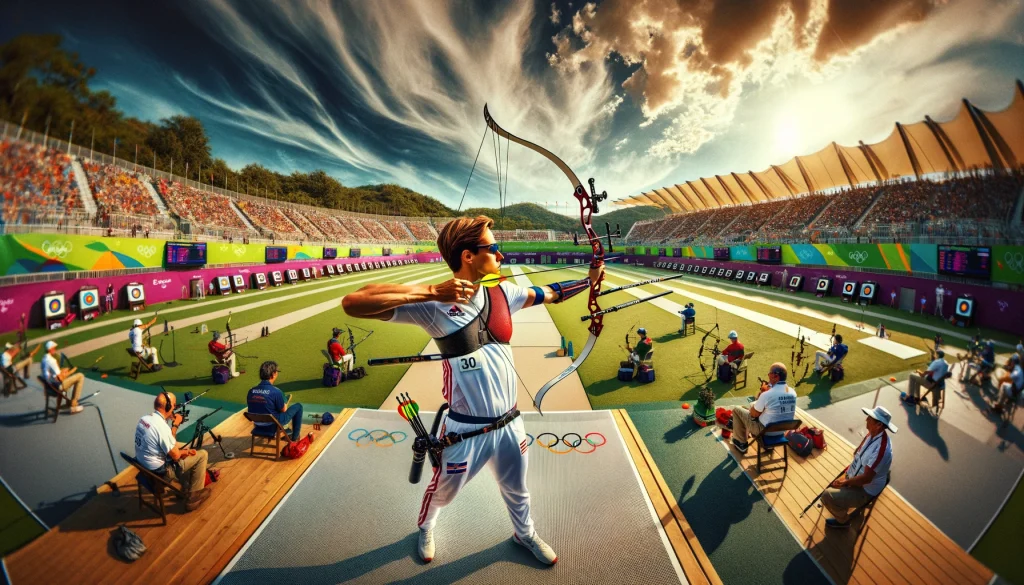
Recurve bow archery at the Olympics represents the pinnacle of precision and skill in the sport of archery. The Olympic Games employ the recurve bow, a modern evolution of traditional bows, designed with advanced materials to optimize performance.
Athletes participating in this discipline demonstrate their concentration and accuracy as they aim at targets over short distances and long distances, following a tradition that has been a part of the Olympics since the early 20th century.
Archers at the Olympics compete in individual event, mixed team event and team events, showcasing their prowess in the intense atmosphere of the games. The use of the recurve bow is exclusive to this platform, and athletes draw the string with their fingers, typically using a sight to refine their aim.
Each archer has their technique, developed through years of training, and the moment the arrow is released downrange captures the essence of the sport’s challenge and the athlete’s skill.
The format of Olympic recurve archery includes set points and match play, which is designed to test the archers’ consistency and ability to perform under pressure. Whether in individual duels or team collaborations, athletes must navigate the variables of wind and psychological stress, all while maintaining the form and focus required to hit a target approximately the size of a grapefruit from 70 meters away, reflecting the rigorous standards expected of Olympic-level competition.
History of Recurve Bow Archery in the Olympics

Recurve bow archery has a storied presence in the Olympics, with roots that span over a century and adaptations that reflect the growth of the sport.
Evolution of Olympic Archery
Traditionally, archery made its Olympic debut in 1900. However, it was not until the 1972 Munich Games that the recurve bow became the standard for Olympic competition. This transition marked archery’s evolution into a highly technical sport fit for modern times. The recurve bow’s unique design, with limbs that curve away from the archer, has been the only discipline featured since then, making its presence integral to the competition.
Significant Milestones
Tokyo 2020 marked a critical point in Olympic recurve bow archery, as it was the first time mixed teams competed, showcasing the sport’s growth and inclusivity. The history of recurve bow archery at the Games also remembers Belgium’s Hubert van Innis as the sport’s most successful Olympian, demonstrating the longstanding individual competition prowess within the discipline.
His record, which includes six gold and three silver medals from the 1900 and 1920 Games, still stands as a testament to the sport’s enduring competitive spirit.
Equipment Used in Olympic Recurve Archery
In Olympic archery, athletes rely on precision-engineered equipment to ensure consistency and high performance. The primary gear includes finely-tuned high-end bows and a set of specialized arrows and accessories.
Olympic Recurve Bows
Olympic recurve bows are distinguished by their unique construction featuring limbs that curve away from the archer when unstrung. These bows are exclusively used in the Olympics, and their design allows for more efficient energy transfer when the arrow is released. For instance, in terms of draw weight, male archers typically use recurve bows drawing around 46-54 pounds, while female archers draw approximately 46-50 pounds on average.
The bows are comprised of advanced materials like carbon fiber, contributing to their physical strength and lightweight properties.
In addition to the main structure, the bow includes an arrow rest, which supports the arrow before and during the draw. The bow may also be equipped with a sight pin that the archer uses for aiming, assisting in achieving the precision required for Olympic-level competition.
Stabilizers play a crucial role in balancing the bow, with long rods extending out the front and short rods – commonly referred to as side rods – attached perpendicularly to lessen torque during the shot.
Arrows and Accessories
Arrows used in Olympic recurve archery are designed for optimal aerodynamics and consistency. They are typically made from materials such as carbon fiber or aluminum to ensure straight flight paths and minimal wind drift. The components of an arrow include the shaft, fletchings, nock, and point, each precision-manufactured to stringent tolerances to maximize accuracy.
Accessory-wise, archers use various supplementary gear such as finger tabs or gloves to protect their fingers, arm guards to shield the arm from the string, and chest guards to prevent clothing from interfering with the release. Each piece is crafted to contribute to the archer’s comfort and performance without imposing restrictions on their movement or technique.
Competition Structure and Scoring

Olympic bow archery includes a meticulous structure that athletes follow, with scoring systems that determine their progression through the major events. The competition encompasses both individual prowess and team coordination across various stages.
Qualifying Rounds
In the qualification phase, archers shoot 72 arrows at a target 70 meters away, aiming to accumulate the highest total score possible. This phase determines the archer’s seeding for the match-play rounds, with a Minimum Qualification Score (MQS) required for entry into the Olympic Games. Men, for instance, must achieve an MQS of 640 points within the qualification period.
Match Play and Scoring Systems
Once seeded, archers enter the match play, where the set system is utilized in individual archery events. Athletes shoot sets of arrows and accrue set points; winning a set garners 2 points, a tie awards 1 point, and no points for a loss. The first to 6 set points wins the match. Team competitions and mixed team events follow a similar structure but with teams shooting four arrows per set.
The cumulative score of these arrows per set determines the set winner. The set system fosters dramatic comebacks and can overturn a match regardless of earlier performances.
Rules and Regulations
In Olympic recurve bow archery, clearly defined standards and requirements are crucial for the fair and consistent conduct of the sport. These rules cover everything from the design and usage of equipment to the eligibility of athletes.
Equipment Standards
- Bow of Choice: Athletes must use a recurve bow. This includes a riser grip and a pair of curved lower limbs, connected by a string, which the archer pulls to full draw.
- Full Draw: The position when an archer pulls the bowstring back to its maximum length before releasing the arrow.
- Draw Weight: The force needed to draw the bow. This varies between athletes but must fall within equipment regulations set by World Archery.
- Draw Length: This is personalized to the athlete and is dependent on their arm span and technique.
Athletes compete at a standard distance of 70 meters from the target face, aiming to ensure consistency and fairness in competition across the board.
Athlete Requirements
- Eligibility: Competitors must be recognized by their National Olympic Committee and the World Archery Federation, adhering to the Olympic Charter.
Strict adherence to these rules ensures every competitor is evaluated fairly, maintaining the integrity of the sport.
Famous Olympic Recurve Archers and Achievements
The recurve bow is the only type of bow Olympians shoot. Over the years, several recurve archers have stood out due to their remarkable performance and have become synonymous with excellence in the sport.
Notable Olympic Archers
- Kim Soo-Nyung: A dominant force in Olympic archery with a tally that includes four gold medals, a silver, and a bronze, making her one of the greatest in the discipline.
- Darrell Pace: An American archer who claimed the gold twice in individual events, also making an indelible mark on the Olympic stage.
- Park Sung-Hyun: A South Korean athlete whose Olympic achievements include gold medals and a multitude of championship titles.
Record-Breaking Performances
- Hubert van Innis: His performance remains legendary, with six gold and three silver Olympic medals, a record that has stood tall for over a century.
- Im Dong-Hyun: Known for setting a world record during the 2012 London Olympics in the men’s individual and team recurve events.
These archers have not only claimed medals but have also offered moments of extraordinary skill and sportsmanship, elevating the sport of recurve archery on the Olympic stage.
